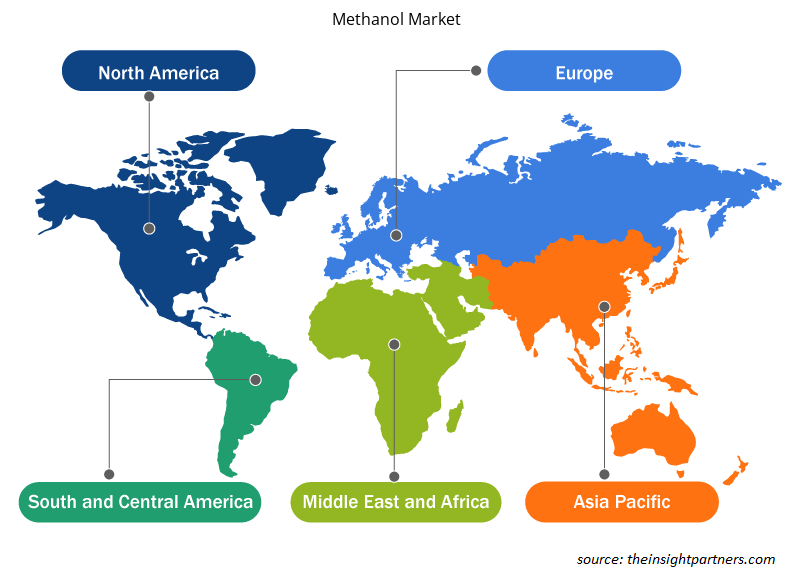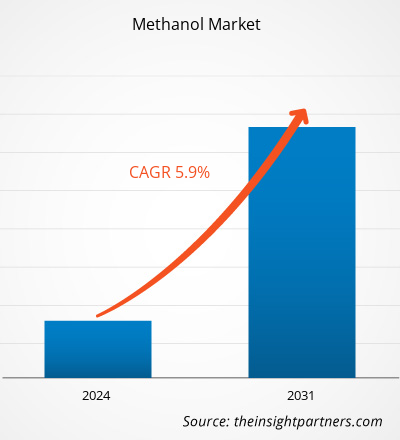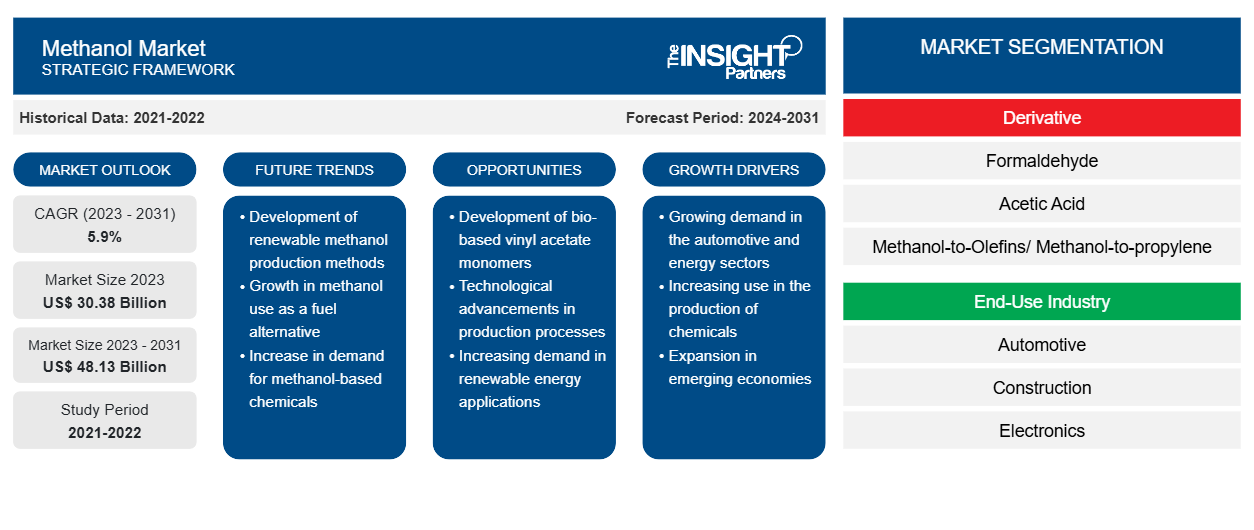Se proyecta que el tamaño del mercado del metanol alcance los 48.130 millones de dólares en 2031, frente a los 30.380 millones de dólares en 2023. Se espera que el mercado registre una CAGR del 5,9 % entre 2023 y 2031. Es probable que la creciente adopción del metanol como combustible mezclado en la industria del transporte siga siendo una de las tendencias clave del mercado del metanol.
Análisis del mercado del metanol
El rápido aumento de las actividades de construcción en diferentes países del mundo está impulsando el crecimiento del mercado del metanol. La industria de la construcción es un sector industrial con mejores perspectivas para México. La industria de la construcción mexicana está creciendo debido al crecimiento económico y la inversión pública en proyectos de infraestructura. México también está avanzando rápidamente hacia actividades de construcción ecológicas y respetuosas con el medio ambiente. En los últimos años, el sector de la construcción en Indonesia ha sido un motor de crecimiento. La rápida urbanización de la población está impulsando la demanda en el sector de la construcción en el país. Además, el crecimiento de la población y el aumento del gasto público en infraestructura son los principales impulsores del mercado de la construcción en Indonesia.
Panorama general del mercado del metanol
El metanol es el compuesto alcohólico más simple utilizado como aditivo en aplicaciones industriales; es un químico líquido inflamable, incoloro y tóxico con un olor insignificante. Se utiliza en diversas industrias, como la automotriz, la construcción, la electrónica, el embalaje, los productos farmacéuticos, las pinturas y los revestimientos, entre otras. El alcohol metílico se utiliza para producir formaldehído, ácido acético y metacrilato de metilo (MMA) y también se utiliza como disolvente en varias aplicaciones. El metanol y sus productos derivados, como el ácido acético y el formaldehído, obtenidos mediante reacciones químicas, se utilizan como materiales de base en plástico acrílico; tejidos y fibras sintéticas que se utilizan para hacer ropa; adhesivos, pinturas y madera contrachapada que se utilizan en la construcción; y como agente químico en productos farmacéuticos y agroquímicos.
Personalice este informe según sus necesidades
Obtendrá personalización en cualquier informe, sin cargo, incluidas partes de este informe o análisis a nivel de país, paquete de datos de Excel, así como también grandes ofertas y descuentos para empresas emergentes y universidades.
-
Obtenga las principales tendencias clave del mercado de este informe.Esta muestra GRATUITA incluirá análisis de datos, desde tendencias del mercado hasta estimaciones y pronósticos.
Factores impulsores y oportunidades del mercado del metanol
Aumento del uso de metanol como materia prima en diversas aplicaciones
El metanol, como componente químico fundamental o como combustible, cuando se elabora a partir de fuentes renovables, puede ayudar a alcanzar los objetivos de descarbonización. El alcohol metílico se utiliza mucho en la producción de plásticos, adhesivos, materiales aislantes, textiles y productos químicos alimentarios, entre otros productos químicos y compuestos. La demanda de plásticos está aumentando debido al crecimiento del sector automovilístico en el mundo. Además, varios derivados del alcohol metílico se utilizan ampliamente en las industrias farmacéutica y sanitaria. Por lo tanto, el aumento del uso de metanol en diversas aplicaciones impulsa el crecimiento del mercado mundial del metanol.
Creciente interés por el uso de metanol ecológico
El metanol verde es aquel que se produce de forma renovable y sin emisiones contaminantes. Este compuesto químico se utiliza como combustible líquido con bajas emisiones de carbono y es una alternativa prometedora a los combustibles fósiles en áreas donde la descarbonización es un gran desafío. En los últimos años, las alternativas sostenibles y con bajas emisiones de carbono a los combustibles fósiles tradicionales se han convertido en una prioridad máxima. Por lo tanto, se espera que el creciente enfoque en el uso del metanol verde ofrezca oportunidades más lucrativas para el crecimiento del mercado.
Análisis de segmentación del informe del mercado de metanol
Los segmentos clave que contribuyeron a la derivación del análisis del mercado de metanol son la industria de derivados y de uso final.
- Según los derivados, el mercado del metanol se segmenta en formaldehído, ácido acético, metanol a olefinas (MTO) / metanol a propileno (MTP), metil terbutil éter (MTBE), metacrilato de metilo (MMA), biodiésel, dimetil éter (DME) y otros. El segmento de formaldehído tuvo una participación de mercado significativa en 2023.
- Por industria de uso final, el mercado está segmentado en automoción, construcción, electrónica, embalaje, productos farmacéuticos, pinturas y revestimientos, entre otros. El segmento de automoción tuvo una participación significativa del mercado en 2023.
Análisis de la participación de mercado del metanol por geografía
El alcance geográfico del informe del mercado de metanol se divide principalmente en cinco regiones: América del Norte, Asia Pacífico, Europa, Medio Oriente y África, y América del Sur y Central.
La región de Asia Pacífico tiene una mayor participación en el mercado mundial. Se espera que América del Norte registre una tasa de crecimiento considerable durante el período de pronóstico. El metanol se utiliza ampliamente en la producción de diversos productos químicos y compuestos como plásticos, adhesivos, materiales de aislamiento, textiles y productos químicos alimentarios. La demanda de plásticos está aumentando y favorece positivamente al mercado del metanol debido a la creciente industria automotriz en la región. La industria automotriz utiliza en gran medida polímeros plásticos para fabricar la estructura interior de un vehículo y otros componentes como un parachoques, sistema de combustible, paso de rueda, manijas de las puertas, pastillas de freno y componentes debajo del capó. La aplicación de componentes plásticos reduce significativamente el peso del vehículo, aumenta su eficiencia de combustible y cumple con las regulaciones ambientales con respecto a las emisiones de carbono de los combustibles fósiles.
Perspectivas regionales del mercado del metanol
Los analistas de Insight Partners explicaron en detalle las tendencias y los factores regionales que influyen en el mercado del metanol durante el período de pronóstico. En esta sección también se analizan los segmentos y la geografía del mercado del metanol en América del Norte, Europa, Asia Pacífico, Oriente Medio y África, y América del Sur y Central.

- Obtenga los datos regionales específicos para el mercado del metanol
Alcance del informe sobre el mercado del metanol
| Atributo del informe | Detalles |
|---|---|
| Tamaño del mercado en 2023 | US$ 30.38 mil millones |
| Tamaño del mercado en 2031 | US$ 48,13 mil millones |
| CAGR global (2023 - 2031) | 5,9% |
| Datos históricos | 2021-2022 |
| Período de pronóstico | 2024-2031 |
| Segmentos cubiertos |
Por derivado
|
| Regiones y países cubiertos |
América del norte
|
| Líderes del mercado y perfiles de empresas clave |
|
Densidad de actores del mercado del metanol: comprensión de su impacto en la dinámica empresarial
El mercado del metanol está creciendo rápidamente, impulsado por la creciente demanda de los usuarios finales debido a factores como la evolución de las preferencias de los consumidores, los avances tecnológicos y una mayor conciencia de los beneficios del producto. A medida que aumenta la demanda, las empresas amplían sus ofertas, innovan para satisfacer las necesidades de los consumidores y aprovechan las tendencias emergentes, lo que impulsa aún más el crecimiento del mercado.
La densidad de actores del mercado se refiere a la distribución de las empresas o firmas que operan dentro de un mercado o industria en particular. Indica cuántos competidores (actores del mercado) están presentes en un espacio de mercado determinado en relación con su tamaño o valor total de mercado.
Las principales empresas que operan en el mercado del metanol son:
- CORPORACIÓN METHANEX
- OCI NV
- BASF SE
- Sabiduría
- COMPAÑÍA QUÍMICA DE GAS MITSUBISHI, INC.
- Empresa Helm AG
Descargo de responsabilidad : Las empresas enumeradas anteriormente no están clasificadas en ningún orden particular.

- Obtenga una descripción general de los principales actores clave del mercado del metanol
Noticias y desarrollos recientes del mercado del metanol
El mercado del metanol se evalúa mediante la recopilación de datos cualitativos y cuantitativos a partir de investigaciones primarias y secundarias, que incluyen publicaciones corporativas importantes, datos de asociaciones y bases de datos. A continuación, se incluye una lista de los avances en el mercado del metanol y las estrategias:
- Mitsui & Co., Ltd. ha acordado adquirir una participación del 49% en el capital de Kasso MidCo ApS ("MidCo"), una filial de European Energy A/S ("EE", una empresa de energía renovable con sede en Søborg, Dinamarca). MidCo posee un negocio de generación de energía solar y e-metanol a través de Solar Park Kasso ApS ("Kasso"), su filial de propiedad absoluta. (Fuente: MITSUI & CO., LTD., sitio web de la empresa/comunicados de prensa /2023)
- Jakson Green, una empresa de energías renovables y nuevas de la India, anunció hoy que ha ganado un proyecto de la National Thermal Power Corporation (NTPC) para establecer una planta de producción de CO2 a metanol en la planta de energía térmica Vindhyachal de NTPC en Madhya Pradesh. (Fuente: PV MAGAZINE, sitio web de la empresa /2023)
Informe sobre el mercado del metanol: cobertura y resultados
El informe “Tamaño y pronóstico del mercado de metanol (2021-2031)” proporciona un análisis detallado del mercado que cubre las siguientes áreas:
- Tamaño del mercado y pronóstico a nivel global, regional y nacional para todos los segmentos clave del mercado cubiertos bajo el alcance
- Dinámica del mercado, como impulsores, restricciones y oportunidades clave
- Principales tendencias futuras
- Análisis detallado de las cinco fuerzas de Porter y FODA
- Análisis del mercado global y regional que cubre las tendencias clave del mercado, los principales actores, las regulaciones y los desarrollos recientes del mercado.
- Análisis del panorama de la industria y de la competencia que abarca la concentración del mercado, el análisis de mapas de calor, los actores destacados y los desarrollos recientes
- Perfiles detallados de empresas
- Análisis histórico (2 años), año base, pronóstico (7 años) con CAGR
- Análisis PEST y FODA
- Tamaño del mercado, valor/volumen: global, regional y nacional
- Industria y panorama competitivo
- Conjunto de datos de Excel
Informes recientes
Testimonios
Razón para comprar
- Toma de decisiones informada
- Comprensión de la dinámica del mercado
- Análisis competitivo
- Información sobre clientes
- Pronósticos del mercado
- Mitigación de riesgos
- Planificación estratégica
- Justificación de la inversión
- Identificación de mercados emergentes
- Mejora de las estrategias de marketing
- Impulso de la eficiencia operativa
- Alineación con las tendencias regulatorias























 Obtenga una muestra gratuita para - Mercado del metanol
Obtenga una muestra gratuita para - Mercado del metanol